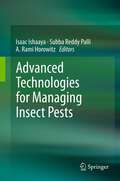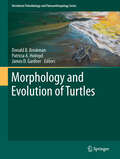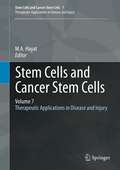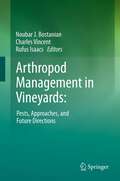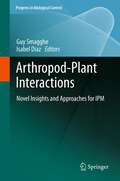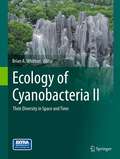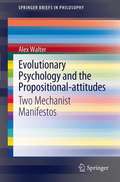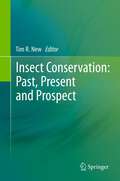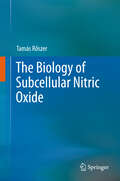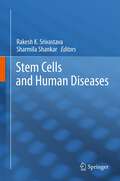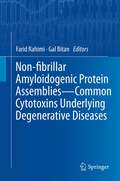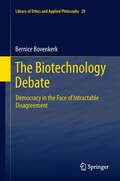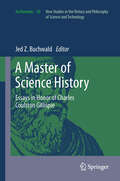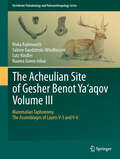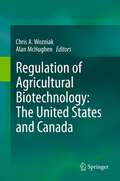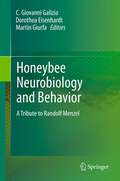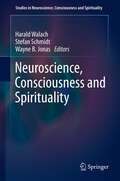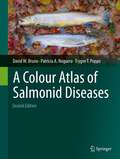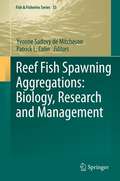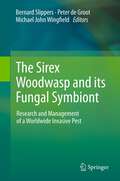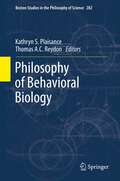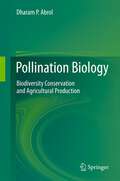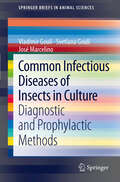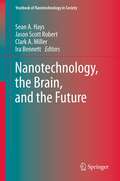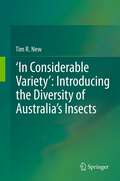- Table View
- List View
Advanced Technologies for Managing Insect Pests
by Isaac Ishaaya, Subba Reddy Palli and A. Rami HorowitzAmong the highlights of this book is the use of novel insecticides acting on a specific site in an insect group and are compatible with natural enemies and the environment. One of such approaches is based on disrupting the activity of biochemical sites acting on transcription factors such as the Helix-Loop-Helix (bHLH) family, anti juvenile hormone (AJH) agents that target JH biosynthetic enzymes, G-protein coupled receptors (GPCR) and bursicon as a target for insect control. Another one is the biotechnology or the genetic approach such as gene silencing (RNA interference) and Bt-crops. Other sections of the book are devoted to the plant’s natural products, optical manipulation and the use of nanotechnology for improving insect control methods.
Morphology and Evolution of Turtles (Vertebrate Paleobiology and Paleoanthropology)
by Donald B. Brinkman, Patricia A. Holroyd and James D. GardnerThis volume celebrates the contributions of Dr. Eugene Gaffney to the study of turtles, through a diverse and complementary collection of papers that showcases the latest research on one of the most intriguing groups of reptiles. A mix of focused and review papers deals with numerous aspects of the evolutionary history of turtles, including embryonic development, origins, early diversification, phylogenetic relationships, and biogeography. Moreover it includes reports on important but poorly understood fossil turtle assemblages, provides historical perspectives on turtle research, and documents disease and variation in turtles. With its broad scope, which includes descriptions of material and new taxa from Australia, Asia, and Europe, as well as North and South America, this work will be an essential resource for anyone interested in the morphology and evolution of turtles. “This volume’s breadth of time, geography, and taxonomic coverage makes it a major contribution to the field and a ‘must have’ for all vertebrate paleontologists.”, James F. Parham, California State University, CA, USA “A comprehensive and sweeping overview of turtle evolution by the top experts in the field that will interest everyone curious about these unique reptiles.” Jason S. Anderson, University of Calgary, Canada “An invaluable addition to the literature that covers the full spectrum of approaches toward understanding the evolution of these noble creatures.” Ann C. Burke, Wesleyan University, CT , USA “A truly comprehensive volume that both the student of fossil turtles, as well as the general reader interested in these enigmatic creatures, will find fascinating.” Tyler Lyson, Yale University, CT, USA
Stem Cells and Cancer Stem Cells, Volume 7: Therapeutic Applications in Disease and Injury (Stem Cells and Cancer Stem Cells #7)
by M. A. HayatThe seventh in Springer’s landmark series of edited volumes on one of the highest-profile subjects in contemporary medicine and scientific endeavour, this volume sets out to cover a staggering range of research into the medical applications of stem cell research. While stem cells are the very stuff of life for multicellular organisms, including us humans, the cancer stem cell is a morbid entity with a robust resistance to therapies including conventional chemotherapy. This authoritative publication explains the regenerative potential of stem cells and their mesenchymal progeny, reviewing clinical applications of the latter in the treatment of cancer, diabetes and neurodegenerative pathologies. It covers the entire range of stem cells with known potential for therapeutic use, from human embryonic to germ cell-derived pluripotent stem cells and hematopoietic stem cells. The chapters also deal with the role of TGF-beta in propagating human embryonic stem cells, and in facilitating their differentiation. Featuring discussions of molecular signaling pathways that modulate mesenchymal stem cell self-renewal and much more, this book is certain to have broad appeal among academicians and physicians alike.
Arthropod Management in Vineyards: Pests, Approaches, and Future Directions
by Noubar J. Bostanian, Charles Vincent and Rufus IsaacsProvides a state-of-the-science overview of arthropods affecting grape production around the world. Vineyard pest management is a dynamic and evolving field, and the contributed chapters provide insights into arthropods that limit this important crop and its products. Written by international experts from the major grape-growing regions, it provides a global overview of arthropods affecting vines and the novel strategies being used to prevent economic losses, including invasive pests affecting viticulture. The book contains reviews of the theoretical basis of integrated pest management, multiple chapters on biological control, current status of chemical control, as well as in-depth and well-illustrated reviews of the major arthropod pests affecting grape production and how they are being managed worldwide. This text will serve as a primary resource for applied entomologists, students, growers, and consultants with interests at the intersection of viticulture and applied entomology.
Arthropod-Plant Interactions: Novel Insights and Approaches for IPM (Progress in Biological Control #14)
by Guy Smagghe and Isabel DiazThe book consists of multiple chapters by leading experts on the different aspects in the unique relationship between arthropods and plants, the underlying mechanisms, realized successes and failures of interactions and application for IPM, and future lines of research and perspectives. Interesting is the availability of the current genomes of different insects, mites and nematodes and different important plants and agricultural crops to bring better insights in the cross talk mechanisms and interacting players. This book will be the first one that integrates all this fascinating and newest (from the last 5 years) information from different leading research laboratories in the world and with perspectives from academia, government and industry.
Ecology of Cyanobacteria II: Their Diversity in Space and Time
by Brian A. WhittonCyanobacteria have existed for 3.5 billion years, yet they are still the most important photosynthetic organisms on the planet for cycling carbon and nitrogen. The ecosystems where they have key roles range from the warmer oceans to many Antarctic sites. They also include dense nuisance growths in nutrient-rich lakes and nitrogen-fixers which aid the fertility of rice-fields and many soils, especially the biological soil crusts of arid regions. Molecular biology has in recent years provided major advances in our understanding of cyanobacterial ecology. Perhaps for more than any other group of organisms, it is possible to see how the ecology, physiology, biochemistry, ultrastructure and molecular biology interact. This all helps to deal with practical problems such as the control of nuisance blooms and the use of cyanobacterial inocula to manage semi-desert soils. Large-scale culture of several organisms, especially "Spirulina" (Arthrospira), for health food and specialist products is increasingly being expanded for a much wider range of uses. In view of their probable contribution to past oil deposits, much attention is currently focused on their potential as a source of biofuel.Please visit http://extras.springer.com/ to view Extra Materials belonging to this volume.This book complements the highly successful Ecology of Cyanobacteria and integrates the discoveries of the past twelve years with the older literature.
Evolutionary Psychology and the Propositional-attitudes: Two Mechanist Manifestos (SpringerBriefs in Philosophy)
by Alex WalterThe two essays provide a critical examination of theory and research in the field of evolutionary psychology. The view advanced here is that philosophical materialism and minimalist assumptions about adaptation serve Darwinian psychology better than the more popular alternative view that relies on cognitive dualism and propositional-attitude psychology to formulate evolutionary psychology theory. A commitment to cognitive dualism is destined to undermine the physical basis of behavior upon which evolutionary theory depends. Many evolutionary psychologists do not see this but are seduced by the easy way in which hypotheses can be formulated using the ‘propositional-attitude’ model. The challenge is to develop a materialistic and mechanistic approach to understanding human cognition and behavior, including linguistic and social behavior.
Insect Conservation: Past, Present and Prospects
by Tim R. NewThe history of interest and practice in insect conservation is summarised and traced through contributions from many of the leaders in the discipline, to provide the first broad global account of how insects have become incorporated into considerations of conservation. The essays collectively cover the genesis and development of insect conservation, emphasising its strong foundation within the northern temperate regions and the contrasts with much of the rest of the world. Major present-day scenarios are discussed, together with possible developments and priorities in insect conservation for the future.
The Biology of Subcellular Nitric Oxide
by Tamás RőszerThis book fills in a gap in the NO literature. Recent progress in the field of NO-biology shows that NO is generated within distinct cell compartments, including specific plasma membrane regions, mitochondria, chloroplasts, peroxisomes, the Golgi-complex and intracellular membrane systems. NO synthesis plays specific roles in these compartments and, in turn, cell organelles also control intracellular NO levels. This monograph focuses on the roles played by the subcellular NO-signaling microdomains in the prokaryote-, fungus-, plant- and animal cells and shows how NO behaves as an intracellular signal in distinct cellular environments. This monograph also provides a summary of our knowledge on how NO synthesis came through evolution to be associated with organelles and subcellular compartments. Promotes the novel ideas that some functions of NO and its associations with subcellular units have been conserved during the evolution of the cell. A special chapter is dedicated to the biomedical relevance of subcellular NO synthesis, and this chapter also discusses the evidence that altered compartmentalization of NO-producing enzymes causes disease.
Stem Cells and Human Diseases
by Rakesh Srivastava and Sharmila ShankarThe main objective of this book is to provide a comprehensive review on stem cells and their role in tissue regeneration, homeostasis and therapy. In addition, the role of cancer stem cells in cancer initiation, progression and drug resistance are discussed. The cell signaling pathways and microRNA regulating stem cell self-renewal, tissue homeostasis and drug resistance are also mentioned. Overall, these reviews will provide a new understanding of the influence of stem cells in tissue regeneration, disease regulation, therapy and drug resistance in several human diseases.
Non-fibrillar Amyloidogenic Protein Assemblies - Common Cytotoxins Underlying Degenerative Diseases
by Farid Rahimi and Gal BitanAmyloid-forming proteins are implicated in over 30 human diseases. The proteins involved in each disease have unrelated sequences and dissimilar native structures, but they all undergo conformational alterations to form fibrillar polymers. The fibrillar assemblies accumulate progressively into disease-specific lesions in vivo. Substantial evidence suggests these lesions are the end state of aberrant protein folding whereas the actual disease-causing culprits likely are soluble, non-fibrillar assemblies preceding the aggregates. The non-fibrillar protein assemblies range from small, low-order oligomers to spherical, annular, and protofibrillar species. Oligomeric species are believed to mediate various pathogenic mechanisms that lead to cellular dysfunction, cytotoxicity, and cell loss, eventuating in disease-specific degeneration and systemic morbidity. The particular pathologies thus are determined by the afflicted cell types, organs, systems, and the proteins involved. Evidence suggests that the oligomeric species may share structural features and possibly common mechanisms of action. In many cases, the structure–function interrelationships amongst the various protein assemblies described in vitro are still elusive. Deciphering these intricate structure–function correlations will help understanding a complex array of pathogenic mechanisms, some of which may be common across different diseases albeit affecting different cell types and systems.
The Biotechnology Debate: Democracy in the Face of Intractable Disagreement (Library of Ethics and Applied Philosophy #29)
by Bernice BovenkerkThis book grounds deliberative democratic theory in a more refined understanding of deliberative practice, in particular when dealing with intractable moral disagreement regarding novel technologies. While there is an ongoing, vibrant debate about the theoretical merits of deliberative democracy on the one hand, and more recently, empirical studies of specific deliberative exercises have been carried out, these two discussions fail to speak to one another. Debates about animal and plant biotechnology are examined as a paradigmatic case for intractable disagreement in today’s pluralistic societies. This examination reveals that the disagreements in this debate are multi-faceted and multi-dimensional and can often be traced to fundamental disagreements about values or worldviews. “One of the acute insights to emerge from this examination is that deliberation can serve different purposes vis-à-vis different types of problem. In the case of deeply unstructured problems, like the modern biotechnology debate, the aim of inclusion is more appropriate than the aim of consensus. This book highlights the importance of political culture and broader institutional settings in shaping the capacity and propensity of citizens to engage in deliberation and the degree to which governments are prepared to relinquish authority to deliberative mini-publics."Robyn Eckersley, University of Melbourne, Australia
A Master of Science History: Essays in Honor of Charles Coulston Gillispie (Archimedes #30)
by Jed Z. BuchwaldNew essays in science history ranging across the entire field and related in most instance to the works of Charles Gillispie, one of the field's founders.
The Acheulian Site of Gesher Benot Ya‘aqov Volume III: Mammalian Taphonomy. The Assemblages of Layers V-5 and V-6 (Vertebrate Paleobiology and Paleoanthropology)
by Rivka Rabinovich Sabine Gaudzinski-Windheuser Lutz Kindler Naama Goren-InbarMultidisciplinary research on the Early-Middle Pleistocene site of Gesher Benot Ya‘aqov has yielded abundant climatic, environmental, ecological and behavioral records. The 15 archaeological horizons form a sequence of Acheulian occupational episodes on the shore of the paleo-Lake Hula. These enable us to reconstruct numerous aspects of the survival and adaptation of ancient hominins, leading to a better understanding of their evolution and behavior. This book presents the faunal analyses of medium-sized and large mammals, providing taxonomic, taphonomic and actualistic data for the largest faunal assemblages. The study of modes of animal exploitation reveals valuable information on hominin behavior.
Regulation of Agricultural Biotechnology: The United States and Canada
by Chris A. Wozniak and Alan McHughenAgricultural biotechnology takes many forms and applications, with the number and diversity of products ever increasing. With this rapid development, regulatory authorities have sought to keep pace through regulatory adjustments and advances to ensure the safe and beneficial use of this critical technology. The regulatory systems for the U.S. and Canada are not static and must evolve in order to maintain relevance, efficiency and applicability to the challenges encountered. The diverse authors, drawn from the biotechnology industry, academia, government research and regulatory agencies, offer their perspectives of the historical and current system and suggest where it can be improved in the future. Based upon vast experience interacting with the regulatory system, the editors and authors offer demystifying views of the US and Canadian regulatory structures and how they came to be. We know of no other effort to present the biotechnology regulatory systems of the US and Canada in an open forum which will benefit those in the regulated community as well as those charged with oversight of the products of biotechnology, and ultimately the consumer!
Honeybee Neurobiology and Behavior: A Tribute to Randolf Menzel
by C. Giovanni Galizia, Dorothea Eisenhardt and Martin GiurfaThe book is a sequel of a similar book, edited by Randolf Menzel and Alison Mercer, “Neurobiology and Behavior of Honeybees”, published in 1987. It is a “Festschrift” for the 70th birthday of Randolf Menzel, who devoted his life to the topic of the book. The book will include an open commentary for each section written by Randolf Menzel, and discussed with the authors. The written contributions take their inspiration from a symposium on the topic, with all the authors, that was held in Berlin in summer 2010
Neuroscience, Consciousness and Spirituality (Studies in Neuroscience, Consciousness and Spirituality #1)
by Harald Walach, Stefan Schmidt and Wayne B. JonasNeuroscience, Consciousness and Spirituality presents a variety of perspectives by leading thinkers on contemporary research into the brain, the mind and the spirit. This volumes aims at combining knowledge from neuroscience with approaches from the experiential perspective of the first person singular in order to arrive at an integrated understanding of consciousness. Individual chapters discuss new areas of research, such as near death studies and neuroscience research into spiritual experiences, and report on significant new theoretical advances. From Harald Walach’s introductory essay, “Neuroscience, Consciousness, Spirituality – Questions, Problems and Potential Solutions,” to the concluding chapter by Robert K. C. Foreman entitled “An Emerging New Model for Consciousness: The Consciousness Field Model,” this book represents a milestone in the progress towards an integrated understanding of spirituality, neuroscience and consciousness.It is the first in a series of books that are dedicated to this topic.
A Colour Atlas of Salmonid Diseases
by David W. Bruno Patricia A. Noguera Trygve T. PoppeSalmonids have widespread economic and environmental importance. Correct identification and understanding of their diseases are therefore vital if valuable stocks are to be maintained. This volume provides a practical guide and an aid to disease recognition. This is an updated and extended version of the first publication in 1996 and contains around 400 high quality colour photomicrographs.
Reef Fish Spawning Aggregations: Biology, Research and Management (Fish & Fisheries Series #35)
by Yvonne Sadovy Sadovy de Mitcheson and Patrick L. L. ColinReef fish spawning aggregations, ranging from small groups to many tens of thousands of individuals, are spectacular but poorly known natural phenomena whereby fish assemble at specific times and locations to spawn. For some species these large groups may be the only form of reproduction, the high fish numbers briefly giving a false impression of stability and abundance—an ‘illusion of plenty’. They are often a focus for intensive seasonal fishing because of their predictability and because many important commercial fishes form them. Highly vulnerable to overexploitation, many aggregations and their associated fisheries, have disappeared or are in decline. Few are effectively managed or incorporated into protected areas. Aggregations are not well understood by fishery scientists, managers and conservationists and their significance little appreciated by fishers or the wider public. To ensure their persistence to replenish important fisheries in coral ecosystems, maintain their ecosystem function and continue to delight divers, a significant change in perspective is needed to foster protection and management. This book provides comprehensive and practical coverage of the biology, study and management of reef fish aggregations, exploring their how, when, where, and why. It explores ways to better protect, study, manage and conserve them, while identifying key data gaps and questions. The text is extensively illustrated with many unique, never before published, photographs and graphics. Case studies on over 20 interesting and important fishes are included, outlining their biology and fisheries and highlighting major concerns and challenges.
The Sirex Woodwasp and its Fungal Symbiont: Research and Management of a Worldwide Invasive Pest
by Bernard Slippers, Peter de Groot and Michael John WingfieldThe Sirex woodwasp, Sirex noctilio, is the most important invasive alien insect pest of Pinus plantations in the Southern Hemisphere. It now also threatens pines in North America. This book brings together the worldwide knowledge of researchers from Universities and Government institutions, as well as forest industry practitioners that have worked on the pest. Importantly, it is the first comprehensive treatment of the subject since S. noctilio was discovered outside its native range around 1900. The book covers all aspects of the biology and management of S. noctilio, including aspects of the insects’ taxonomy, general life history, host-plant relationships, population dynamics, chemical ecology and symbiosis with the fungus Amylostereum areolatum. The book also contains a comprehensive synthesis of the history and current status of the pest and worldwide efforts to control it, including biological control, silviculture and quarantine.
Philosophy of Behavioral Biology (Boston Studies in the Philosophy and History of Science #282)
by Kathryn S. Plaisance and Thomas A.C. ReydonThis volume provides a broad overview of issues in the philosophy of behavioral biology, covering four main themes: genetic, developmental, evolutionary, and neurobiological explanations of behavior. It is both interdisciplinary and empirically informed in its approach, addressing philosophical issues that arise from recent scientific findings in biological research on human and non-human animal behavior. Accordingly, it includes papers by professional philosophers and philosophers of science, as well as practicing scientists. Much of the work in this volume builds on presentations given at the international conference, “Biological Explanations of Behavior: Philosophical Perspectives”, held in 2008 at the Leibniz Universität Hannover in Germany. The volume is intended to be of interest to a broad range of audiences, which includes philosophers (e.g., philosophers of mind, philosophers of biology, and metaethicists), as well as practicing scientists, such as biologists or psychologists whose interests relate to biological explanations of behavior.
Pollination Biology: Biodiversity Conservation and Agricultural Production
by Dharam P. AbrolThis book has a wider approach not strictly focused on crop production compared to other books that are strictly oriented towards bees, but has a generalist approach to pollination biology. It also highlights relationships between introduced and wild pollinators and consequences of such introductions on communities of wild pollinating insects. The chapters on biochemical basis of plant-pollination interaction, pollination energetics, climate change and pollinators and pollinators as bioindicators of ecosystem functioning provide a base for future insights into pollination biology. The role of honeybees and wild bees on crop pollination, value of bee pollination, planned honeybee pollination, non-bee pollinators, safety of pollinators, pollination in cages, pollination for hybrid seed production, the problem of diseases, genetically modified plants and bees, the role of bees in improving food security and livelihoods, capacity building and awareness for pollinators are also discussed.
Common Infectious Diseases of Insects in Culture: Diagnostic and Prophylactic Methods (SpringerBriefs in Animal Sciences)
by Vladimir Gouli Svetlana Gouli Jose MarcelinoThis handbook gives a comprehensive and copious illustrated description, with original art work, of the most common diseases in laboratory reared insect colonies, comprising Viruses (Baculoviridae, Reoviridae, Poxviridae, Iridoviridae); Bacteria (Bacillaceae, Pseudomonadaceae, Enterobacteriaceae); Rickettsia; Fungi and Microsporidia and Protozoa. Gregarine and Coccidian parasitoids are also depicted. Manuals for the diagnostic of insect diseases have been published in the 90’s, however, these were intended for professional insect pathologists or for proficient training in invertebrate pathology, hence requiring some scientific background in insect pathology. Currently, most guides are web based, not comprehensive and solely addressing the most common diseases in a particular insect, or group of insects, reared in laboratory facilities. A comprehensive and proficient practical handbook for students and technicians working with insect reared colonies is lacking in the current literature.
Nanotechnology, the Brain, and the Future (Yearbook of Nanotechnology in Society #3)
by Sean A. Hays, Jason Scott Robert, Clark A. Miller and Ira BennettOur brain is the source of everything that makes us human: language, creativity, rationality, emotion, communication, culture, politics. The neurosciences have given us, in recent decades, fundamental new insights into how the brain works and what that means for how we see ourselves as individuals and as communities. Now – with the help of new advances in nanotechnology – brain science proposes to go further: to study its molecular foundations, to repair brain functions, to create mind-machine interfaces, and to enhance human mental capacities in radical ways. This book explores the convergence of these two revolutionary scientific fields and the implications of this convergence for the future of human societies. In the process, the book offers a significant new approach to technology assessment, one which operates in real-time, alongside the innovation process, to inform the ways in which new fields of science and technology emerge in, get shaped by, and help shape human societies.
‘In Considerable Variety’: Introducing the Diversity of Australia’s Insects
by Tim R. NewThe book introduces basic entomology, emphasising perspectives on insect diversity important in conservation assessment and setting priorities for management, as a foundation for managers and others without entomological training or background. It bridges the gap between photographic essays on insect identification and more technical texts, to illustrate and discuss many aspects of taxonomic, ecological and evolutionary diversity in the Australian insect fauna, and its impacts in human life, through outlines of many aspects of insect natural history.
